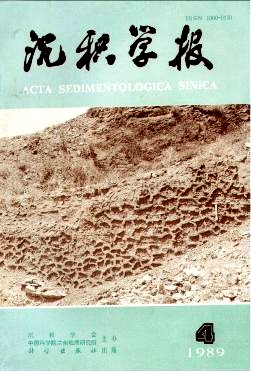SHALLOW EVAPORATIVE ENVIRONMENT FOR THE FORMATION OF NAHCALITE-BEARING SERIES IN THE BIYANG BASIN, HENAN
- Received Date: 1987-03-14
- Publish Date: 1989-12-10
Abstract: Occurring at the bottom of the He-No.2 member of the Hetaoyuan formation, the Anpeng nahcalite-bearing series is made up of rocks of four lithotypes.The first type is a fine to silty rock dominated by feldspar, with cements of aphanitic dolomite, and showing such sedimentary structures as current bedding, cross bedding and ripple mark.Next to the first, oil shale in fact represents a kind of organic rich microcrystalline dolomite propably compared with the oil shale formation of the Green River trona deposit, USA, consisting of aphanitic dolomite and laminated organic materials.The third type is provided by dolomite with a great amounts of the minerals of zeolite race and aggregate of shortite.Texturally, it locally has the form of intraclasl and, structurally, harizontal bedding, current bedding, drying cracks and washing marks only found in the contact with the overlying fine to silty rock. The finaltype is composed of principal bicarbonate and subnate wegscheiderite which scatter in the microcrystalline dolomite but highly concentrate to thiness of 15cm in Ihe core. The Anpeng nahcalite-bearing series is abundant in sedimentary structurces including ripple marks, washing prints, current bedding and drying cracks. The nahcalite-bearing silt in the Bi-No.69 barehole has individul ripple marks measured at wave lenth of 1.7cm, wave height of 0.28cm, wave trace index of 6.1 and symmetric index of 1.23.Taking the form of doubl-peak, some typical ripple marks are attributed to the reworking of the previous wave-formed ones.The attribution of the ripple marks reveals that the surfaces of the silt beds during deposition were direetly against the front of wave, a circumstance characteristic of fairly shallow basins.The then depth was less than 1.53m according to the auther ' s calculation using B,Diem ' s formula which is based on Airy wave theory and applicable to the estimation of paleodepth and some other paleowave parameters by wave-formed ripple mark.This further supports the shallowness of the basin where Ihe silt deposited. Washing structures develops a great deal at the uppermost part of the dolomhe whose lamellae seems to be cut cross by the overlying silt which is set down in those washing channels.Like the washing structures, current bedding is seen always in the dolomhe and sometimes in the whole nahcalite-bearing series, belonging to a small-sized bedding relative to running water. All the sedimentary structures appear so frequently the dolomite that a more strongly hydrodynamic regime is also believed to exist when the dolomite must be subjected to running water and wave action during deposition. Besides the above structural features, drying cracks are very of the found at intervals of teens to tens cm in the dolomite.They are in the form of irregular "V" or "U" and infilled with argillaceous and sandy miterials analogous IithoIogeally to those from the overlying silt.Its general but interval development in the dolomite allows that it emerged many times from the waters during formation and became carbonate mud flat.lt is from this almost wholly dried mud flat that what is now called as metasyngenetic dolomite generated by evaporative pumping. Some other evidences for the shallow deposition of the dolomite are given by its carrying a number of elliptical doloraatic gravels and stratified dolomatic cuttings. In a word, many aspects of sedimentary structures and their assemblages of the dolomite point to a shallow, even shallower and shallower to thoroughly dried, basin where the nahcalite-bearing series deposited. On the basis of paleobotanical and paleopolynological analyses combined with studies of sedimentary rhythms and structures, the period when the He-No.2 member took place is char acteristic of semi-arid to arid climate highly favorable for the evaporation of the basin. Lithological types, depositional rhythms, sedimentary structures and fades zonation, all exhibit that the Anpeng area was not deep at least during the deposition of the nahcalite-bearing series or the lower part of the member but shallow, thus leading to intersive evaporation. Such a sedimentary environment caused sedimentary structures, depositional rhythms, fades zonation etc. to become, ingeneral, good analogs to those of the Green River trona deposit which may be explained by so-called playas model. This model suggests facies distribution pattern from the margin of the basin to the centre, i.e., along the margin lime-cemented sandstone and conglomerate, in the middle cxtersively exposed, mainly doloraatic, carbonate mud flat, and at the centre bicarbonate owing to extreme shallowness and sometimes even dryup.
| Citation: | Zhou Jianmin, Wang Jiping. SHALLOW EVAPORATIVE ENVIRONMENT FOR THE FORMATION OF NAHCALITE-BEARING SERIES IN THE BIYANG BASIN, HENAN[J]. Acta Sedimentologica Sinica, 1989, 7(4): 149-156. |






 DownLoad:
DownLoad: